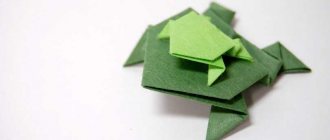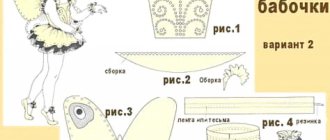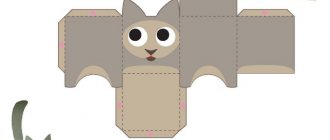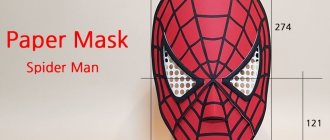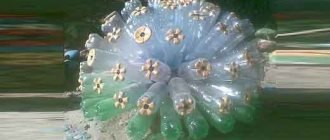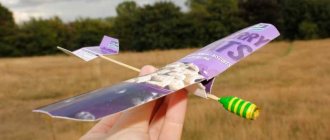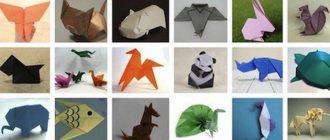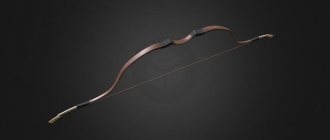5/5 — (1 vote)
Good day to all!
If you like crafts, then you will be interested in this article. In it I will try to show a lot of different ideas on how to make a rocket from all kinds of materials that you have at home. We will mainly make it from paper or cardboard, and also use other available materials.
Basically, such rockets (plus various other space souvenirs) are made for all famous holidays, for example, February 23 or Cosmonautics Day. Or they give it to veterans on Victory Day. And moreover, there are flying models, there are flat ones, such as postcards or applications, origami and even something like houses. In general, get ready for it to be hot behind the wheel).
Take any master class and start creating, using step-by-step instructions that will help you with this.. I think it won’t be too difficult to repeat all the steps.
So, go ahead, friends, and I hope that you will like all the works presented and that you will come to my site every year and use new ideas. Let's get down to business, our hands are already itching to do something like this with our children. Go!
Paper rocket for kids
Roll a cylinder from a rectangle, and a cone for the top from a semicircle. Separately glue the portholes and side supports in the form of small cones. If you want the rocket to be a little more stable, use thicker paper or thin cardboard for the base. This is an ideal craft for kindergarten: extremely easy, understandable and bright.
Photo: paper-land.ru
Options for doing the job
All crafts related to space themes can be divided into two large groups - those that do not have volume (flat) and volumetric ones.
Flat
Flat crafts are of less interest, but are great for implementation in the junior and middle groups of kindergarten.
The main difference between such crafts is the lack of volume. An example of how to do the work would be a rocket appliqué made from geometric shapes from pre-prepared templates. A flat rocket on a stick or string looks original and beautiful.
Volumetric
Volumetric products are more complex in execution. They require children to have skills in working with paper, cardboard, glue and other creative materials.
Common examples of volumetric rockets include:
- Made from cardboard and paper;
- from plastic bottles;
- using origami technique;
- papier mache;
- from toilet paper rolls.
The design options for the spacecraft are varied.
A simple rocket for beginners
This is a very simple origami pattern that even small children can handle in a few steps. The rocket folds up like a house, only then you need to bend the sides to the other side with steps. The finished craft is suitable for appliques, decorating cards or creating holiday packaging.
Photo: handmade.jofo.me
Flight and results
Characteristics of the assembled rocket:
- Length: 1300 millimeters
- Diameter: 50 millimeters
- Case weight (with all components): 1000 grams
- Electronics weight: 180 grams
- Engine weight: 440 grams
- Total weight: 1620 grams
- Engine: DKR-30-9-280-PE(S)
- Class: H115, maximum thrust - 180 N*s
- Estimated (maximum) apogee: 530 meters
- Time to apogee: 11.5 seconds
The rocket took off.
The flight was generally successful, the rocket reached its apogee at 400 meters.
The rocket landed with a parachute 200 meters from the launch site.
The parachute has opened!
It is curious that the data from the accelerometer shows spikes corresponding to the operation of the rescue system (mortar).
Raw data from logger
Simple rocket with notches
This scheme is very similar to the previous one, but at the same time a little different. Thanks to small cuts at the bottom, the side supports are more expressive and realistic. This diagram looks good even from one-sided colored paper, and add portholes and other little things on top.
Photo: infourok.ru
Crochet napkins: 6 simple patterns for beginners
Origami rocket with colored fire
This origami rocket looks interesting from one-sided colored paper, and it is the fire that remains bright, and the frame itself is white. Place the rectangle with the white side up, bend the part back to a square. Shape the corners and sides to create a kind of house. Turn the workpiece over, form the side walls with a ladder, turn it around again and spread the colored fire down.
Photo: podelunchik.ru
Origami paper rocket
This diagram is similar to the previous one and starts in the same way with a standard origami triangle. Fold the sides towards the middle and arrange each corner into a thin diamond shape on all four sides separately. Wrap the side supports with a ladder, hide the fold under the base of the rocket and form a curly transition.
Photo: zuowen2.info
Amigurumi for beginners: 6 simple patterns step by step
Wide origami rocket
Another similar scheme from the basic triangle differs from the previous ones in that the finished rocket is much wider. Fold the bottom corners up, lay each of them into a square, bend it in half and lay it out again. Tuck the central part and unfold it into another similar, already third, house.
Photo: rci76.ru
Engine
Unlike rocket modeling, amateur, “candy” rocket science uses its own manufactured engines. Rocket engines are a long and extensive conversation that can be stretched into more than one article. To put it very briefly, in most cases, amateur rocketry uses solid-fuel engines, which are very similar in design to the engines of real solid-fuel rockets.
The difference lies in the materials from which the engine is made and the fuel used. Most often, paper, plastic or composite (glass roving) is used to make engines. In my case - plastic (reinforced polypropylene pipe with an outer diameter of 40 mm). A mixture of potassium nitrate and sugar/sorbitol in a ratio of 65/35 is used as fuel. Actually, when such a mixture melts, a sweet mass (inedible!) is formed, similar to caramel, which is where the name “caramel fuel” comes from.
C6H14O6 + 3.345 KNO3 -> 1.870 CO2 + 2.490 CO + 4.828 H2O + 2.145 H2 + 1.672 N2 + 1.644 K2CO3 + 0.057 KOH
The fuel is pressed into so-called “fuel blocks” - cylinders with a hole. The size of the checkers is selected in such a way that during engine operation the fuel has time to burn out evenly in all directions (in the direction from the internal channel to the edge). The optimal length of a checker with outer diameter D and inner diameter d is length L=1.67D. The checkers are necessarily pressed/wrapped into the so-called “armor” - the outer non-flammable shell of the checker. The armor prevents the bomb from burning on the outer surface, which is unacceptable. Too large a fuel burning area can lead to engine destruction.
Fuel checkers
The blocks form an engine assembly with a single fuel channel. In this case, the checkers are placed in a heat-insulating (non-flammable) tube made of Teflon/paper impregnated with silicate glue. Thermal insulation is needed in order to prevent engine destruction due to temperature (combustion front and hot gases) during fuel combustion.
Engine diagram
Caramel fuel burns relatively slowly, so to create thrust, the engine is ignited at the farthest point of the channel (opposite from the nozzle). Important engine parameters, in addition to thrust, are the nozzle rating and operating pressure. The higher the pressure in the engine, the greater the thrust. The higher the pressure, the higher the fuel combustion rate. The real challenge in creating an engine is the task of creating a solution that, with a minimum mass of the body, will maintain maximum pressure and contain the largest amount of fuel.
Traction chart
Pressure graph
To calculate the engine, calculations based on the combustion law are used. Of course, there are ready-made solutions for calculating engine parameters.
In addition, bench tests of engines are required. This allows you to test the reliability of the engine on the ground, as well as take real readings of the engine thrust (which may differ from the calculated ones).
Cluster engine on a traction measuring stand
Rocket made from cardboard tubes
If you want to assemble a larger and stronger model, take a sheet of cardboard and cylindrical bushings. A base made from any rolled paper or paper towels will do. Cut out the main parts and make side cuts to connect them, like a simple 3D puzzle. Before assembly, paint and decorate the rocket with gouache and PVA or acrylic paints.
Photo: pinkstripeysocks.com
Paper origami for beginners: 10 easy patterns
Craft for children
We suggest not finishing with the material studied, but making another model. The manufactured element can not only be played with, but also decorate the interior of the room. The construction process is so easy that a child can easily handle it. The main thing is to follow our instructions.
To construct such a layout, you need to prepare:
- a roll of napkins or toilet paper;
- thick cardboard, preferably white;
- red and yellow paper;
- beautiful shiny self-adhesive paper;
- tape, preferably made of paper;
- silver and red paint;
- figurine of an astronaut and scissors.
If everything is ready, we begin construction:
- We prepare two bushings of the same size.
We leave one of them whole, and cut the second, as shown in the image. Based on the diameter of the tube, cut out three circles of a suitable size from cardboard. - We fix one circle on the smallest tube. We cut out more such details and insert them into the middle. We draw and cut out the wings for our rocket.
- We install these blanks on the body. We make a sharp front part of the model and glue it in place. We paint the blades and cut out the silhouette of a flame from red paper.
We attach it to the back of the craft. Then we measure the size of the body, cut out a suitable part from adhesive paper and cover the rocket with this material.
The layout is ready. Having studied our lessons in detail, you can easily make a variety of crafts for Cosmonautics Day.
